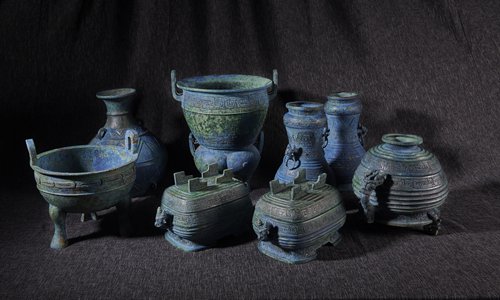HOME >> ARTS
Chinese bronze artifacts repatriated from Japan to debut in Beijing
By Bi Mengying Source:Global Times Published: 2019/9/10 18:54:49

A set of eight bronzes once belonging to a noble family of the Eastern Zhou Dynasty's (770BC-256BC) Zeng State Photo: Courtesy of China's National Cultural Heritage Administration
After an exhaustive five-month-long investigation and collaboration between authorities in China and Japan, a set of ancient bronze relics that had been smuggled overseas in recent years were returned home in late August.
The eight bronze wares are among the most valuable relics to be successfully brought back to China in recent years, China's National Cultural Heritage Administration (NCHA) said on Tuesday during a media event in Beijing announcing the return. The bronzes will be put on public display for the first time ever at a large-scale exhibition in Beijing focusing on repatriated Chinese cultural treasures.
To the rescue
On March 3, the NCHA was notified that a set of Chinese bronze artifacts was being listed for auction on the website of Japanese auction house Tokyo Chuo. Looking into the background information about the items it appeared they were China's cultural relics that had been smuggled abroad at some point.
"We launched an investigation immediately and in just three days obtained crucial clues and evidence about tomb raiding and relic smuggling," said NCHA Deputy Director Guan Qiang.
By studying the features, decorations and inscriptions of the bronze artifacts, the NCHA surmised that they had been excavated from ancient graves that belonged to a noble family of the Zeng State in what is today the city of Suizhou in Central China's Hubei Province. Further investigation revealed that the artifacts had appeared once in Shanghai in 2014, but no records were found in national database showing that they had legally left the country. Based on this evidence, investigators theorized that the objects had been smuggled to Japan sometime after 2014.
The NCHA reached out to the Chinese Embassy in Japan and began collaborating with local authorities in Japan. It wasn't long before Tokyo Chuo announced on March 9 that it was canceling the auction. After five months collaborating with Japanese authorities, the holder of the relics, surnamed Zhou, agreed to return to China for investigation and hand over the relics. A small group from the NCHA and China's Ministry of Public Security left for the Chinese Embassy in Japan on August 20 and brought the relics back home days later.
Cultural value
After the relics' return, authorities and experts conducted a series of comprehensive evaluations and determined them to be national-level artifacts dating back to the early Spring and Autumn Period (770BC-476BC).
"Based on the corrosion analysis, we can conclude that the relics were unearthed in recent years. The whole set includes various types of bronze artifacts such as food and water vessels. They were delicately crafted and well-preserved. All eight have inscriptions exceeding 330 characters that reveal abundant historical and cultural information," Guan explained.
Guan noted that the set of relics holds significant academic value to the study of the history, culture and the craftsmanship of the Spring and Autumn Period.
The return of these relics couldn't have come at a better time as they will now make their public debut at a large-scale exhibition of repatriated Chinese cultural treasures set to be held at the National Museum of China in Beijing on September 17 to mark the 70th anniversary of the founding of the People's Republic of China (PRC).
The planning of the exhibition started at the beginning of this year, and more than 600 pieces of returned artifacts were selected from 18 organizations across the nation to present the country's achievements in repatriating lost antiques over the past 70 years.
Lost and found
Since 1949, more than 150,000 lost relics have been returned to China by different methods, such as law enforcement cooperation, litigation, negotiation and donations.
The exhibition focuses on just 25 cases of repatriated lost relics. Renowned relics such as a stone relief from the tomb of Wang Chuzhi (863-923), a senior military governor in ancient China, will also be on display.
Discovered in 1980 in Quyang county of North China's Hebei Province, his grave was plundered in 1994 and the painted marble relief panels were stolen. One of the panels was advertised for sale in the US in 2000. Upon the request of Chinese authorities, US Customs seized the panel and returned it to China in 2001.
Aside from precious relics, the exhibition also presents the stories of these retrieved relics through photos, texts and videos, some of which have never been released before. For instance, the exhibition will show a video of Zhou Enlai, the first premier of the PRC, accepting a flag for the Boxer Rebellion, an anti-imperialist movement that took place in China between 1899 and 1901, returned by what was then East Germany in 1955.
Newspaper headline: Coming home
Posted in: ART